The knowledge of pagan Roman frescoes have survived the classical world, and it is based mainly on the frescoes from Pompeii.
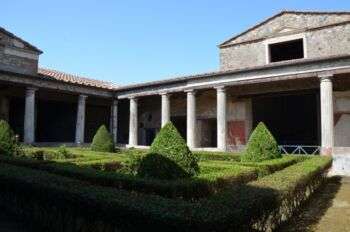
Image source:https://search.creativecommons.org/photos/421aa851-7987-43dd-8a77-1cd615c613cd by Carole Raddato from FRANKFURT, Germany
Classification
The four « Pompeian » styles of wall decoration were identified by the German archaeologist August Mau in “Pompeii, Its Life and Art” at the end of the 19th century. The classification can be made by styles and refers to the decorated wall as a whole. When considering single paintings, as is often the case in museums, the ability to assign a specific style to a painting depends on three factors: the design of the painting, the date of the painting, and the type of decoration that surrounds it. The examples in museums have unfortunately been removed from their original context. The four styles can be classified as follows:

Image source: http://www.pompeiin.com/en/Painting_styles.html
- The first style (masonry) is characterized by the simulation of marble plating with other simulated elements, such as alabaster discs suspended in vertical lines, wooden beams in yellow and pillars or cornices in white. There are often bright colors, which was considered a sign of wealth at the time.
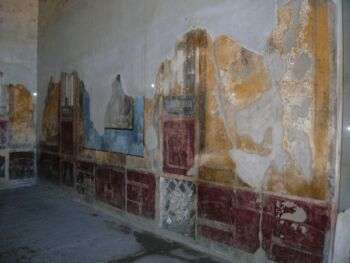
Image source: https://search.creativecommons.org/photos/01aa7450-fa63-4989-b288-4dcfbe2f1331 by Mentnafunangann
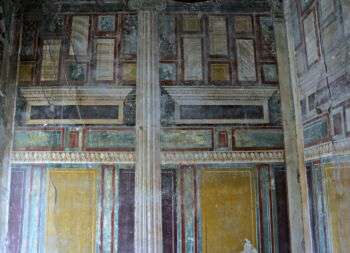
Image source: https://search.creativecommons.org/photos/0990e22b-8fc5-4487-8f9d-28c927bcd4aa by Mentnafunangann
- In the second style (illusionism) the walls were decorated with architectural elements and “trompe-l’oeil” compositions. Elements of this style recall the first style, but it began to be substituted element by element. This technique consists in highlighting elements to make them look like three-dimensional realities, and was a method often used by the Romans.
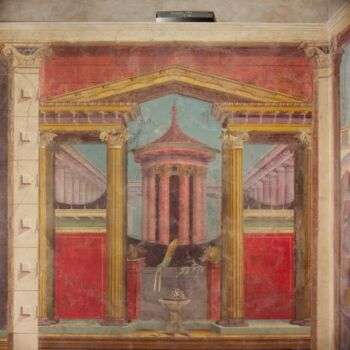
Image source: https://search.creativecommons.org/photos/fbda81fd-9e09-4acc-ae1a-8ee58fb83e41
- the third style is a reaction to the austerity of the previous period. It is characterized by a more figurative and colorful decoration, with a more ornamental overall feeling, and often finesse in the execution. This style is generally noted as elegant simplistic. Defined as “fantastic style”, it is heterogeneous and incorporates elements of all previous styles. In addition, it can be best described as a combination of the previous three styles.
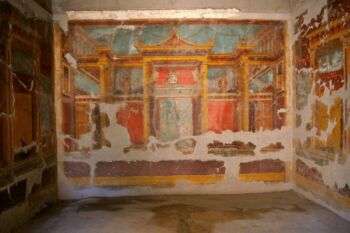
Image source: https://search.creativecommons.org/photos/e7ae8e8b-4c42-4d83-bacc-c5c6f2af8702 by pablocabezos
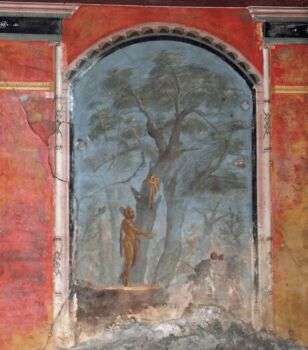
Image source: https://search.creativecommons.org/photos/19dd2679-499e-4496-97d6-58b6e05b8114 by Amphipolis
- the fourth style in Roman wall painting is generally less decorated than its predecessor. It is characterized as a baroque reaction to the mannerisms of the third style. In addition, it is more complex, it revives narrative painting on a large scale and the panoramas while retaining the architectural details of the first two styles.

Image source: https://commons.wikimedia.org/wiki/File:Casa-Lucretius-Fronto-Pompeii.jpg
After the pompeian painting
August Mau takes us to Pompeii and the paintings there, but what about Roman painting after 79 A.J.? The Romans continued to paint their houses and monuments, but there is no fifth or sixth style. Later, Roman painting was called a pastiche of what came before. The Christian catacombs provide an excellent record of painting in late antiquity, combining Roman techniques and the Christian subject in unique ways.


Image source: https://search.creativecommons.org/photos/2935b193-6c77-4ec4-a49f-b35a2f3a67da by rokorumora

Image source: https://search.creativecommons.org/photos/1e4b2fb3-a03d-42e0-8005-4e8c3d4191ce by rokorumora
